|
|
|
|
.
Station Artwork Guide:
Listed By
Artist
.
|
By Station/Route | By Artist Name | By Artwork Name
|
.
|
|
|
|
.
Station Artwork Guide:
Listed By
Artist
.
|
By Station/Route | By Artist Name | By Artwork Name
|
.
Listed below is the permanent artwork mounted at CTA stations, listed by artist in alphabetical order of last name.
One panel of Adam Brooks'
Untitled work, depicting a quote from Haki Madhubuti,
renowned African-American author, educator, and poet, is
mounted over the stairs from the platform to the station
house. For a larger view, click here.
(Photo courtesy of CTA Arts in
Transit Program) The other two panels of Adam
Brooks' Untitled work, with quotes from former boxer
Muhammad Ali on the left and African-American Christian
theologian James Cone on the right, are in the station house
framing the vertical access to the platform. For a larger
view, click here.
(Photo courtesy of CTA Arts in
Transit Program) Artist: Brooks, Adam Title: Untitled Station: Location: Interior northeast and southeast
diagonal walls in area adjacent to escalator/stair and
exterior west wall above stairway at platform
level Media: Glass mosaic with water jet cut
lettering Dimensions:.. (Left panel) 8' 10" x 7' 2" (right
panel) 8' 10" x 7' 8" (elevated panel) 4' 4" x 10'
9" Installation
Completed: October, 2004 Notes: Adam Brooks uses
quotes by individuals linked to Chicago to represent broad
ideas about what it means to be human. The words of these
contemporary figures create meaning within the site. The
quotes in this artwork were chosen to reflect a wide-range
approach to human thought and understanding. Each of the
three individuals whose quotes are used -- Muhammad Ali,
James Cone, and Haki Madhubuti -- was a pioneer in his
field. Muhammad Ali is the original archetype for the modern
poet; James Cone is a minister, writer and a professor at
the Union Theological Seminary in New York; Haki Madhubuti
is a Chicago-based poet and publisher who founded the Third
World Press. Adam Brooks is a
Chicago artist who has successfully turned his conceptual,
often text-based work, into interesting and beautiful public
art. As a professional artist and curator he has work in the
collection of the Art Institute of Chicago and has shown at
the Museum of Contemporary Art. Brooks is also a professor
at Colombia College.


The mosaic Vida
Simple is seen looking west on the purposely-built wall
to the north of the station house, facing the small plaza on
the corner of Damen and Cullerton. For a larger view, click
here.
(Photo courtesy of CTA Arts in
Transit Program) A detail view of the glass
and stone tilework of the Vida Simple mosaic. For a
larger view, click here.
(Photo courtesy of CTA Arts in
Transit Program) Artist: Chavez, Juan Angel Title: Vida Simple Station: Location: Exterior west wall of plaza north of
the station house Media: Glass, stone & granite mosaics
with screen printed and painted glass insets Dimensions:.. 9' x 25' 4" Installation
Completed: October, 2004 Notes: Inspired by the
neighborhood of Pilsen, this multimedia mosaic focuses on
the individuality of the people that created the heritage
and cultural identity of the community. The design itself is
a collage of imagery taken from the neighborhood, including
community member portraits, local street scenes, and
industrial wildlife -- birds, small animals, and plants that
reside and grow in the industrial landscape. Juan Angel Chavez is a
Mexican artist living and working in the Pilsen community
surrounding Damen station. He has both a long history of
making public works of art in Chicago, as well as diverse
studio work, which includes sculptural installations
exhibited at both the Museum of Contemporary Art Chicago and
the Mexican Fine Arts Center Museum.
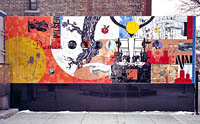
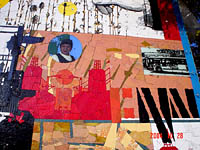
Hopes and Dreams, as
seen looking south from street level, inside the entrance to
the transfer tunnel from the Orange/Green Line station. For
a larger view, click here.
(Photo by Amy
Malick) Detail view of Hopes and
Dreams from the middle landing of the stairs from the
transfer tunnel to street level. For a larger view, click
here.
(Photo by Amy
Malick) Artist: Chavez, Juan and Corinne
Peterson Title: Hopes and Dreams Station: Roosevelt (Red
Line -
Orange/Green
Line) Location: Transfer tunnel
stairway/atrium Media: Ceramic mosaic Dimensions:.. 1600 square feet Installation
Completed: 2001 Notes: Located at the
Roosevelt station the transfer tunnel, connecting the
Orange, Green and Red lines. at 1,600 square feet this
mosaic is composed of more that 4,000 tiles, created by men,
women and children on the Museum Campus in the summer of
1999. Participants were asked to create images relating the
themes that link the citywide, yearlong cultural exploration
of Project Millennium: origins, transitions, new directions,
discovery and technology, the environment, and shaping
community. They also incorporated their hopes and dreams for
the new millennium into their carved tiles. The mosaic
design takes the form of a shifting landscape. Tiles shape
the clouds, plants, trees, forests, oceans, earth and space.
The entire composition can also be seen to be a human figure
in nature, symbolizing the constant human search to
understand nature, our surroundings, and ourselves.
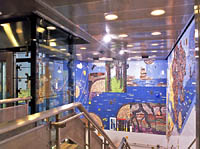
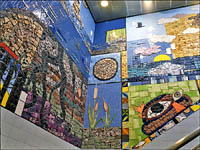
Larger version of Seeds
of the Future... are installed at the Kildare auxiliary
entrance and feature a center panel depicting children
watering plants in their neighborhood. For a larger view,
click here.
(Photo courtesy of CTA Arts in
Transit Program) The smaller Seeds of the
Future... panels at the Kostner entrance depict corn
growing up from open books -- also use as side panels on the
larger installation above -- symbolizing human growth. For a
larger view, click here.
(Photo courtesy of CTA Arts in
Transit Program) Artist: Coron, Beatrice Title: Seeds of the Future Are Planted
Today Station: Location: East and west station
entrances Media: Water jet cut stainless
steel Dimensions:.. (west entrance @ Kostner) 58" x 70"
67" x 70"; (east entrance @ Kildare) 2 x (112" x
70") Installation
Completed: October, 2004 Notes: This project aims to
plant seeds of thought. Icons of growth and transformation
take root in the past to transform our future. In the center
panel, young children are watering the city, representing
hope for the future. The side panels reflect the importance
of education and literacy as the open books at the bottom
the pages sprout with plants, symbolizing human
growth. Beatrice Coron was
born in France and currently lives and works in New York
City. Coron is traditionally a paper-cutting artist. Her
paper-cutting techniques were translated into a stainless
steel work for this project as well as a commission for the
City of New York. Her work is collected in both the United
States and Europe.
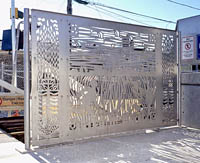
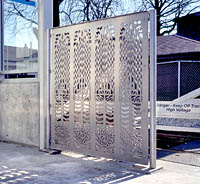
The mosaic Ice Cream
Dream is seen mounted within the 1935 Art Deco terra
facade of the former Western station, both mounted on a
purpose-built wall in front of Western Substation, next to
the new Western station. For a larger view, click
here.
(Photo courtesy of CTA Arts in
Transit Program) Artist Hector Duarte is seen
in his studio working on a mixed media version of Ice
Cream Dream, which he used as a basis for creating the
glass and ceramic pieces for the mosaic. For a larger view,
click here.
(Photo courtesy of CTA Arts in
Transit Program) Artist: Duarte, Hector Title: Ice Cream Dream Station: Location: Exterior east wall of plaza south of
station house framed by historical terra cotta Media: Glass mosaic with ceramic
insets Dimensions:.. 8' 10" x 24' 8.5" Installation
Completed: November, 2004 Notes: At the center of this
mosaic is a large heart with several buildings featuring the
neighborhood's unique architectural characteristics and
facades. Surrounding the heart are the Sears Tower and John
Hancock Building, signifying the neighborhood's place in the
city. Monarch butterflies are the predominant theme
throughout the mural; like many people who pass through this
station daily, monarchs are migrants. Every year the monarch
travels thousands of miles from Mexico to the Midwest. The
butterflies emerge in the mural as a wave of energy, a
reflection of magical realism that has marked Latin American
literature. Hector Duarte is a
Mexican artist who has lived in the neighborhood around the
Western Station since he moved from Mexico in 1985. An
established muralist, Duarte's work is not only in the
Pilsen neighborhood, but also throughout Chicago. He has
received commissions from the City of Chicago, Chicago
Public Schools and the Chicago Historical Society. While
living in Mexico, he studied at the David Alfaro Siqueiros
Mural Workshop in Cuernavaca.
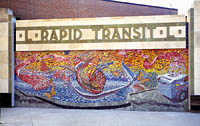
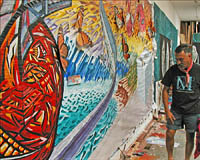
View of Nicole Gordon's
Untitled work at 54/Cermak station, mounted in the
exterior elevation facing the bus terminal. For a larger
view, click here.
(Photo courtesy of CTA Arts in
Transit Program) Artist: Gordon, Nicole Title: Untitled Station: Location: Exterior wall at eastern entrance ramp
from bus drop off area Media: Paint on ceramic tile Dimensions:.. 7' x 17.5' Installation
Completed: November, 2004 Notes: This painting on
ceramic tile depicts a tapestry in which Cicero's rich
cultural history and diversity unfolds. Cicero is a town
that is historically noted as a working class community
composed primarily of immigrants that have strived to
establish themselves and realize the American dream. A
township map of Cicero serves as a foundation of the piece,
as well as decorative references to the cultures that
comprise the community. Some of the town's most important
streets and landmarks provide a structural element, upon
which the narrative unfolds. Nicole Gordon is a
Chicago artist with strong gallery following of her work.
Ms. Gordon holds a BFA from Michigan University in Ann
Arbor. She often uses 18th Century wallpaper or other
domestic patterns as a starting point to her narrative
landscapes. This is Nicole's first major public
commission.

Cannas & Corn is
seen on the south walls of Central Park's paid area. For a
larger view, click here.
(Photo courtesy of CTA Arts in
Transit Program) A young community member is
seen making tiles for the Cannas & Corn mosaic at
a workshop. For a larger view, click here.
(Photo courtesy of CTA Arts in
Transit Program) Artist: Gude, Olivia Title: Cannas & Corn Station: Location: Interior south wall in area adjacent
to escalator Media: Glass and ceramic mosaic Dimensions:.. 8' 10" x 17' 3.5" Installation
Completed: October, 2004 Notes: This mosaic
commemorates the ephemeral public art form of the community
garden. North Lawndale has an active tradition of dedicated
people who transform abandoned urban spaces into
neighborhood amenities. They describe their work as "blight
into sight." The mosaic was fabricated in a community mosaic
workshop to "plant the seeds" of mosaic making skills in the
community so that locally made public art can become part of
the garden making process. Olivia Gude, a senior
artist for the Chicago Public Art Group, is a local artist
who has over twenty years experience in creating public art.
Also a professor at the University of Illinois at Chicago,
Olivia is passing on the skill and essence of mosaic as an
art form through both teaching and organizing mosaic
workshops for her own projects.
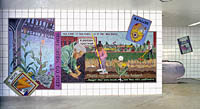
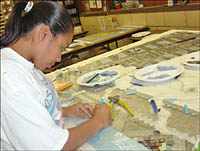
The ceramic tiles of
Coast of Chicago are seen on the wall facing the
stairs at Kedzie station. Elements of the local history,
community, and transit can be found in the tiles' graphics.
Can you find the silhouette of the original Kedzie station
platform canopies? For a larger view, click here.
(Photo courtesy of CTA Arts in
Transit Program) Artist: Himmelfarb, John Title: Coast of Chicago Station: Location: Interior southwest wall in area
adjacent to stairs Media: Custom-made ceramic tiles Dimensions:.. 8' 11" x 11' 1.5" Installation
Completed: October, 2004 Notes: The neighborhood
surrounding the Kedzie station is full of bustling activity.
The ceramic tiles of this artwork reflect the strength of
community as a whole, but also the uniqueness of its
individual parts. Many of the design elements are drawn from
architectural details of homes, schools, commercial
buildings, as well as structural details associated with the
CTA. These sources reflect the current community and give
reference to the history of the neighborhood. Combined with
this imagery are design elements inspired by connections of
heritage to Mayan, Aztec, and African cultures. John Himmelfarb is a
Chicago artist whose studio is located along Cermak Branch
of Blue Line. Himmelfarb received a BA and MA from Harvard
University. As a painter and multimedia artists his work is
in the collection of Art Institute of Chicago and many other
collections, both nationally and internationally.
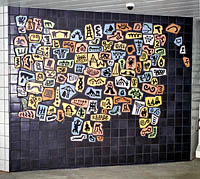
Harlem station, 1984
seen through the glass wall of the station, across the
outbound lanes of the Kennedy Expressway. There are also
images on the other side, facing the station interior. For a
larger view, click here.
(Photo by Amy
Malick) Artist: Katz, Alex Title: Harlem station, 1984 Station: Location: Station house interior, along the
north wall in the paid area Media: Enamel on aluminum Dimensions:.. 8' x 50' Installation
Completed: 1984 Notes: The Harlem station
mural is a striking, freestanding painting by
internationally renowned artist Alex Katz. The painting
celebrates Chicago's immense diversity and its reputation as
a city of hardworking people. The expansive Harlem station
is one of the largest and most complex pieces Katz has
created.
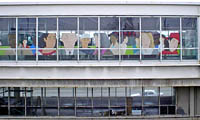
Space Junction of
Energy, see situated in the middle of the stairs and
ramp up to the Kimball station platforms. For a larger view,
click here.
(Photo by Graham
Garfield) Another view of Space
Junction of Energy, showing its context within the rest
of Kimball station, looking south. For a larger view, click
here.
(Photo by Graham
Garfield) Artist: Jacquard, Jerald Title: Space Junction of
Energy Station: Location: Stairway from station house to
platform Media: Sheet metal Dimensions:.. ? Installation
Completed: 1974 Notes: Space Junction of
Energy is a sheet metal sculpture by Jerald Jacquard and
provided the theme for
CTA's modernization of the terminal in 1972. This site-specific
sculpture is integrated with the system of ramps and stairs
that links the station house with the platforms, and is an
excellent example of the successful integration of public
art with the design of a transit space. Space Junction of
Energy is believed to be the first specially-created
artwork designed for and installed in a
CTA rail station. Today, art installations are included in
nearly all of
CTA's station construction and renovation projects.
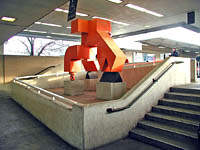
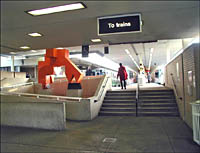
River Road Ring, seen
over the courtyard at the center of Rosemont station. For a
larger view, click here.
(Photo by Graham
Garfield) A view of River Road
Ring from platform level, looking down into the station
courtyard. For a larger view, click here.
(Photo by Graham
Garfield) A close-up of River Road
Ring, looking up from the station courtyard. For a
larger view, click here.
(Photo courtesy of the City of
Chicago Public Art Program) Artist: Puryear, Martin Title: River Road Ring Station: Location: Atrium between elevated platform and
concourse Media: Wood Dimensions:.. 30' diameter Installation
Completed: 1985 Notes: This wood sculpture by
Martin Puryear elegantly described the open-air space within
the structure of Rosemont station. The River Road Ring,
whose name was derived from the station's original name
(River Road), was a visually seamless arc of polished wood
culminating in overlapping ends at the top of its tilted
radius, which connected the upper and lower levels of the
transportation facility. Wood and other natural materials
were also common in Puryear's work, and like the
biomorphic forms he creates, reflect his interest in
biology, nature and landscape. River Road Ring was a
particularly dynamic example of Puryear's talent for
integrating the natural and the manmade. Based in
rural Accord, New York, sculptor Martin Puryear first
studied biology before earning a BA in painting and an MFA
in sculpture. In 1978, he moved to Chicago, where he began
his career and became Professor of Art & Design at the
University of Illinois, Chicago. He remained in Chicago
until 1990. Puryear is the recipient of numerous awards,
including the coveted John D. and Catherine T. MacArthur
Foundation Fellowship Award, commonly known as the "Genius
Grant," and the grand prize for best artist at the 1989 Saso
Paulo Bienal (Brazil). The sculpture was removed in 2011 due to deterioration of the piece, owing to the materials used and the location of its installation. The artwork could not have been repaired and would have needed to be recreated, which was not financially feasible.
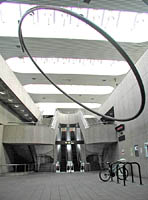
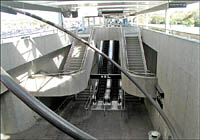
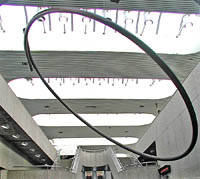
Rock Bow seen from
the upper level of the Cumberland atrium. For a larger view,
click here.
(Photo by Graham
Garfield) Rock Bow seen from
the ground level of the Cumberland atrium. For a larger
view, click here.
(Photo by Graham
Garfield) Artist: Ross, Charles Title: Rock Bow Station: Location: Central atrium between rail station
and bus terminal Media: Liquid-filled acrylic with granite
base Dimensions:.. 31' x 8' Installation
Completed: 1982 Notes: The Rock Bow is
aligned so that at certain times of the year, during the
early morning and late afternoon, direct sunlight strikes
the prisms that cast large bands of spectrum color onto the
walls and floor of the station. Looking directly through the
prisms, one sees the surrounding environment bathed in
rainbow color. The quality of this color is ever-changing,
depending on the light of the station. The light-altering
prisms sit upon three brushed stainless steel legs that
create the support of a tripod. The prisms not only cast
bands of spectrum but also project bands of white light.
These lines continuously change their geometry as they move
through the space with the passage of the sun. Ross was born in
Philadelphia, Pennsylvania and was educated at the
University of California, Berkeley where he received degrees
in Mathematics and Sculpture. The artist has exhibited in
numerous one-person and group shows throughout the United
States. Ross has also been selected for several prestigious
commissions internationally.
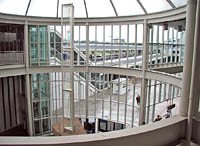

Amor, seen looking
southeast covering most of the south walls of the paid area
at California station. For a larger view, click
here.
(Photo courtesy of CTA Arts in
Transit Program) A close-up of Amor
shows the work's intricate tilework and how it overlaps and
interacts with the standard square white tiles used to clad
the rest of the station interior, a Douglas renovation
design standard. For a larger view, click here.
(Photo courtesy CTA Arts in
Transit Program) Artist: Silva, Christopher Tavares Title: Amor Station: Location: Interior southeast diagonal wall in
area adjacent to escalator Media: Glass and stone mosaic Dimensions:.. 8' 9" x 15' 9.5" Installation
Completed: November, 2004 Notes: The circular flight of
birds from heart to heart suggests the passing of love from
person to person and place to place, as well as the coming
and going of passengers. The migration of birds from clear
to rainy skies symbolically endorses the virtues of
promoting love through times of both happiness and
hardship. Chicago artist
Christopher Tavares Silva started out as a street artist and
has become an important painter and muralist in Chicago. He
has work in the City of Chicago Public Art Collection and
has been a long time member of the Chicago Public Art Group.
The imagery of birds is a continuous symbol that Silva uses
in both his public and studio work.
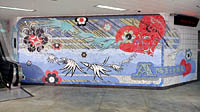
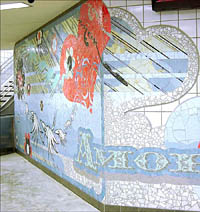
Birth of Heroes,
mounted at the main entrance to Kostner, has images of
famous African-Americans, the community, and the "L"
screened onto its tiles. For a larger view, click
here.
(Photo courtesy of CTA Arts in
Transit Program) Artist: Watkins, Ivan Title: Birth of Heroes Station: Location: Exterior wall north of west (Kostner)
entrance (main entrance) Media: Digital transfer onto tile Dimensions:.. 9' x 6' Installation
Completed: August, 2004 Notes: Inspired by the
Mandala, a precise yet universal symbol of unity, harmony
and the cyclical nature of life, this mural incorporates not
only aspects of spirituality but also the reflection of
great African American contributors of the past and present.
Also incorporated in this digitally transferred mural is
imagery of the Lawndale neighborhood. A lasting concept of
this mural is to evoke education. Ivan Watkins, as an
established public muralist and social scientist, holds a
degree in Fine Art from the School of the Art Institute of
Chicago and a Masters in Social Science from the University
of Chicago. Watkins has completed public murals throughout
the country, most of them educational artworks focusing on
African American History.
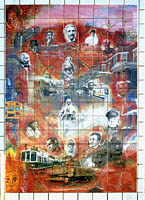
Text courtesy of CTA Arts in Transit Program.
|
By Station/Route | By Artist Name | By Artwork Name
|
.
|
|